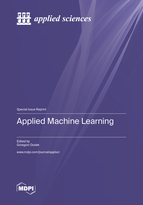Applied Machine Learning
A special issue of Applied Sciences (ISSN 2076-3417). This special issue belongs to the section "Computing and Artificial Intelligence".
Deadline for manuscript submissions: closed (31 October 2020) | Viewed by 153389
Special Issue Editor
Interests: machine learning; evolutionary computation; artificial intelligence; pattern recognition; data mining and applications in forecasting, classification, regression, and optimization problems
Special Issues, Collections and Topics in MDPI journals
Special Issue Information
Dear Colleagues,
Machine learning (ML) is one of the most exciting fields of computing today. Over the past few decades, ML has become an entrenched part of everyday life and has been successfully used to solve practical problems. The application area of machine learning is very broad, including engineering, industry, business, finance, medicine, and many other domains. ML covers a wide range of learning algorithms, including classical ones such as linear regression, k-nearest neighbors or decision trees, through support vector machines and neural networks, or newly developed algorithms such as deep learning and boosted tree models. In practice, it is quite challenging to properly determine an appropriate architecture and parameters of ML models so that the resulting learner model can achieve sound performance for both learning and generalization. Practical applications of ML bring additional challenges, such as dealing with big, missing, distorted, and uncertain data. In addition, interpretability is a paramount quality that ML methods should aim to achieve if they are to be applied in practice. Interpretability allows us to understand ML model operation and raises confidence to its results.
This Special Issue focuses on applications of ML models in a diverse range of fields and problems. Application papers are expected reporting substantive results on a wide range of learning methods, discussing conceptualization of a problem, data representation, feature engineering, ML models, critical comparisons with existing techniques, and interpretation of results. Specific attention will be given to recently developed ML methods, such as deep learning and boosted tree models.
Prof. Grzegorz Dudek
Guest Editor
Manuscript Submission Information
Manuscripts should be submitted online at www.mdpi.com by registering and logging in to this website. Once you are registered, click here to go to the submission form. Manuscripts can be submitted until the deadline. All submissions that pass pre-check are peer-reviewed. Accepted papers will be published continuously in the journal (as soon as accepted) and will be listed together on the special issue website. Research articles, review articles as well as short communications are invited. For planned papers, a title and short abstract (about 100 words) can be sent to the Editorial Office for announcement on this website.
Submitted manuscripts should not have been published previously, nor be under consideration for publication elsewhere (except conference proceedings papers). All manuscripts are thoroughly refereed through a single-blind peer-review process. A guide for authors and other relevant information for submission of manuscripts is available on the Instructions for Authors page. Applied Sciences is an international peer-reviewed open access semimonthly journal published by MDPI.
Please visit the Instructions for Authors page before submitting a manuscript. The Article Processing Charge (APC) for publication in this open access journal is 2400 CHF (Swiss Francs). Submitted papers should be well formatted and use good English. Authors may use MDPI's English editing service prior to publication or during author revisions.






